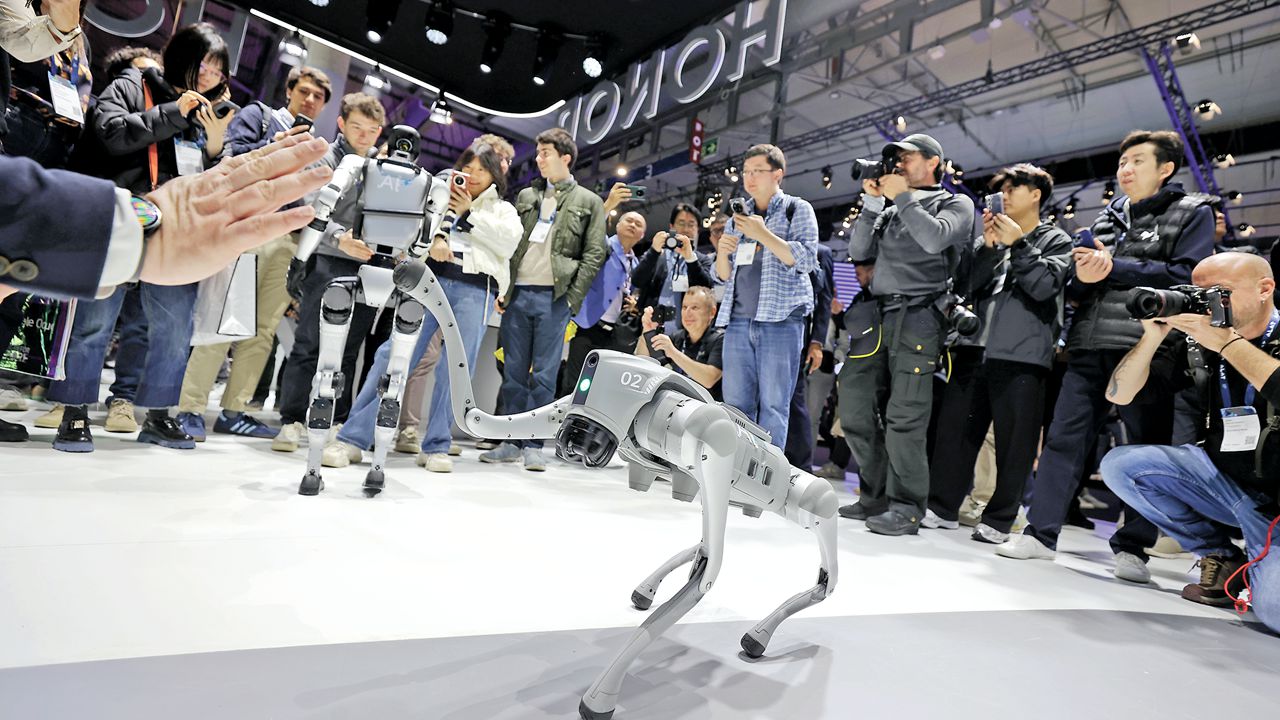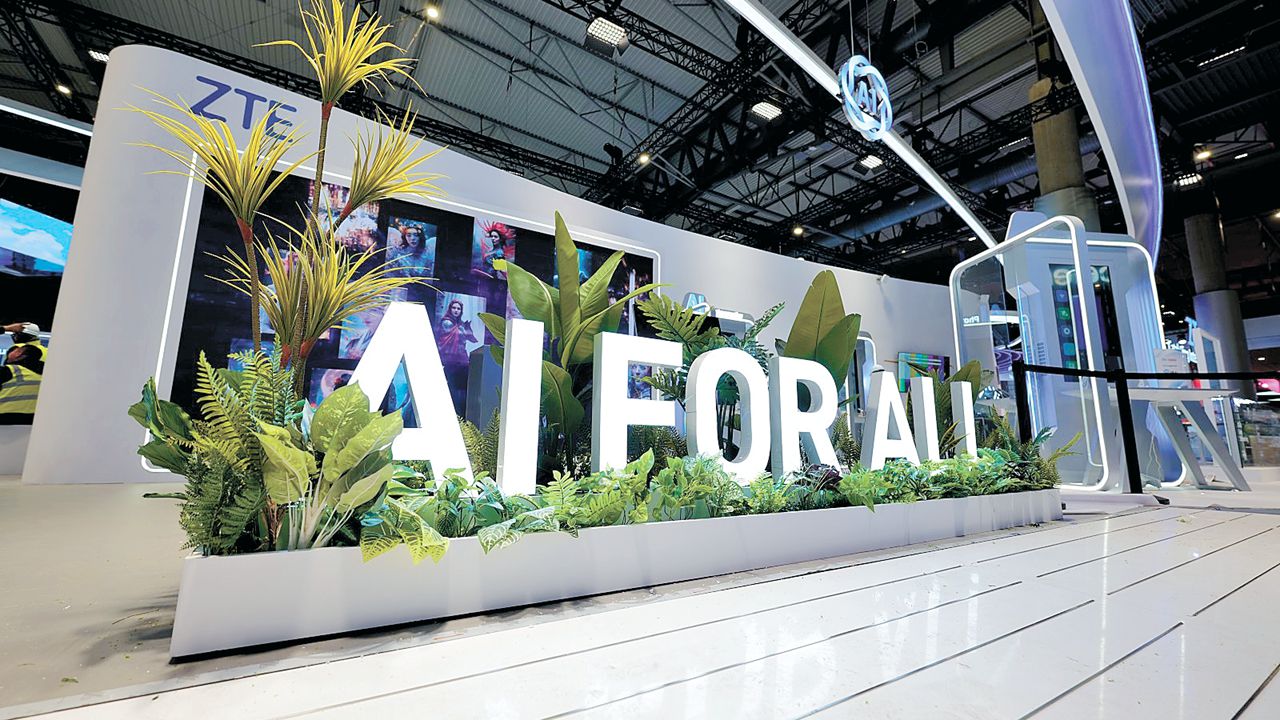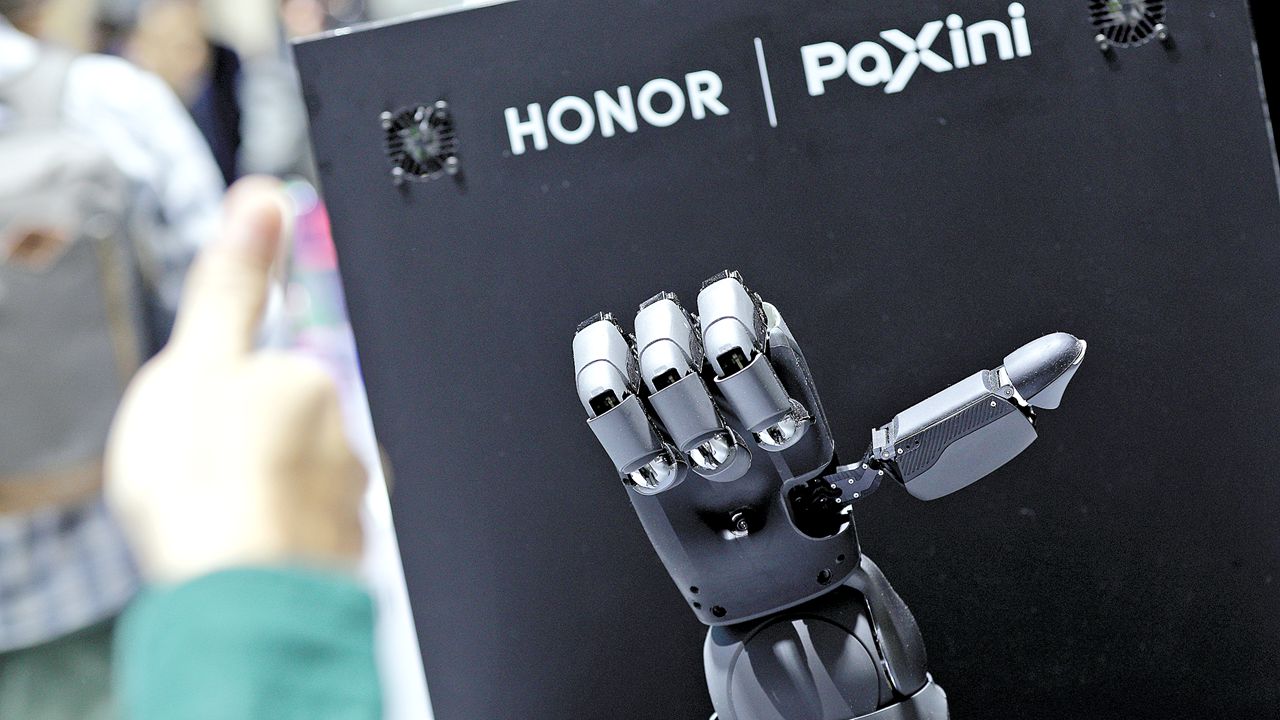How Chinese AI-powered products are transforming mobile world
Writer: | Editor: Zhang Zhiqing | From: | Updated: 2025-03-11
Artificial intelligence (AI) has firmly established itself as a core component of the mobile and telecommunications industry. This was clear during the 2025 Mobile World Congress (MWC), held in the northeast coastal Spanish city of Barcelona, where industry leaders, policymakers, and technology innovators met to explore advancements in the fusion of mobile and AI-driven technologies.

A model of Tecno AI glasses is featured on a background screen at the company’s booth during the 2025 MWC. Photos from Xinhua except otherwise stated
Chinese companies, at the forefront of this transformation, showcased a wide array of cutting-edge products that integrate AI into every aspect of connectivity and smart devices at the world’s leading mobile tech gala, which concluded Friday.
Dawn of ‘AI+’ era
AI technologies have evolved into “fundamental infrastructure and a core capability that fully enables economic and social transformation,” He Biao, executive director and CEO of China Mobile, said in a keynote speech. AI’s rapid development, he said, is triggering systemic shifts across daily life, production, and governance, heralding the arrival of the “AI+” era.
During the exhibition, Shenzhen-based smartphone maker Honor announced its transition from a smartphone manufacturer to an “AI-driven smart device ecosystem company.” The company unveiled the “Honor Alpha Plan,” which aims to integrate human-centric AI into smartphones, unlocking new possibilities for human potential.
The AI revolution will reshape the smart device industry, fundamentally transforming productivity, society, and culture in unprecedented ways, said Honor CEO Li Jian.
Tecno, another Shenzhen-based smartphone maker, introduced its Next-Gen AI Ecosystem, which includes AI-powered smartphones, laptops, glasses, earphones, and smartwatches. Tech giant Lenovo also made waves with its ThinkBook “codename Flip,” a device that redefines professional workflows through AI-enhanced adaptability.
On the opening day of the tech gala, a moment that captured headlines was when King Felipe VI of Spain shook hands with Kuavo, a humanoid robot made by Shenzhen-based Leju Robotics.

A visitor and a quadruped robot give each other a high five at the Honor booth during the 2025 Mobile World Congress in Barcelona, Spain.
As China’s first open-source HarmonyOS humanoid robot designed for family scenarios, Kuavo is capable of jumping, multi-terrain walking, and performing tasks such as washing, watering flowers, and drying clothes.
Equipped with the KaihongOS system — developed by Shenzhen Kaihong based on the OpenHarmony platform, and integrated with the large language model (LLM) from the Harbin Institute of Technology’s Research Center for Social Computing and Interactive Robotics — Kuavo boasts powerful real-time perception, decision-making, and interaction capabilities.
Another standout was Tina, a humanoid robot developed through a collaboration between Shenzhen-based ZTE and Tlibot.
“MWC is where industries meet, and this year’s event showed just how fast technology is reshaping the world around us,” said John Hoffman, CEO of GSMA, the organizer of the event. He noted that discussions on AI-powered networks and smart mobility are set to drive industry trends in the coming year.
Intelligent connectivity
The convergence of AI, 5G-Advanced (5G-A), and the Internet of Things is driving intelligent connectivity and transforming industries worldwide. At MWC 2025, leading telecom companies such as Huawei and ZTE unveiled integrated “5G-A+AI” solutions that leverage large AI models for complex R&D challenges, autonomous networks, and self-driving systems.
Global telecom operators are rolling out 5G-A commercial services across more than 200 cities, revolutionizing live-streaming, gaming, urban mobility, and business travel.
“Human society is advancing rapidly toward an intelligent world, where ubiquitous smart applications demand stronger network capabilities,” said Li Peng, Huawei’s senior vice president and president of ICT sales and services. He highlighted AI’s role in optimizing network performance and reducing latency.

ZTE’s booth at the 2025 MWC highlights the company’s slogan, “AI for all.”
China Unicom, a leading Chinese telecom operator, introduced its “AI Unites All Plan,” aiming to advance AI-network integration and make AI more accessible across industries. “With forward-looking planning and sustained investment, we prioritize integrated innovation in computing infrastructure, network connectivity, data resources, model development, and application scenarios,” said Jian Qin, president of China Unicom.
Since 2019, China Telecom and China Unicom have been jointly pioneering 5G network infrastructure and creating the world’s largest, fastest shared standalone 5G network. At the event this year, they are unveiling the next phase of 5G-A innovation, leveraging shared network data to enhance efficiency and connectivity.
A key highlight of the event was the announcement of the winners of the 30th Global Mobile Awards, one of the industry’s most prestigious honors. Chinese companies, including Huawei, ZTE, China Mobile, and Xiaomi, won multiple industry awards across multiple categories, underscoring their growing influence in the world.
Intl. collaboration
As AI and telecommunications advance at an unprecedented pace, calls for greater international collaboration are growing.
No single country or company can fully harness the potential of 5G, AI-driven networks, and the emerging 6G ecosystem alone, said Luigi Gambardella, president of the Brussels-based digital association ChinaEU.
A global approach is essential for driving innovation, ensuring security, and addressing shared challenges such as digital inclusion, cybersecurity, and sustainability, Gambardella added.

Spanish King Felipe VI (2nd, L) waves to Kuavo, a humanoid robot made by Shenzhen-based Leju Robotics, during a visit to the 2025 Mobile World Congress. File photo
China has evolved from merely following standards to actively co-shaping the rules in cutting-edge fields like 5G-A and 6G, said prof. Guan Ke of Beijing Jiaotong University. Echoing Guan, Martin Creaner, director general of the World Broadband Association, emphasized that there are huge opportunities for Europe and China to collaborate.
As the mobile congress demonstrates, AI is no longer just a feature but a driving force behind the next generation of telecommunications, smart devices, and intelligent networks. With expanding global cooperation and increasing technological breakthroughs, the “AI+” era is poised to reshape the digital world in ways we have only begun to imagine.
Chinese innovation hailed
A combination of scale and innovation has positioned China’s mobile industry at the forefront globally, Mats Granryd, director general of GSMA, said during an interview at MWC 2025. He stated that Chinese companies are leading the way by rapidly applying cutting-edge technologies such as AI and 5G, among others.
He noted that China has successfully integrated all key components of the mobile ecosystem to create a robust, advanced industry. “The scale of the mobile market in China has greatly facilitated the adoption of new technologies,” Granryd said. “It will be really interesting to see how this unfolds in the long term.”

A visitor gives a thumbs-up while a robot hand developed by Shenzhen-based Poxini gestured at the Honor booth during the 2025 Mobile World Congress in Barcelona, Spain.
Lara Dewar, GSMA’s chief marketing officer, highlighted China’s relentless drive for innovation.
A frequent visitor to China, Dewar said she is consistently inspired by the advancements she witnesses, citing the country’s commitment to expanding 5G networks that now serve over a billion users. “China’s influence on this industry is undeniable.”
The two executives also underscored the value of collaboration. Granryd described international cooperation as “vital” to unlocking the mobile industry’s economic potential.
Looking ahead to this year’s MWC Shanghai, Dewar expressed excitement about seeing China’s technological advancements firsthand.
“It will be incredible to visit and see technology come to life,” she said.
MWC 2025 attracted 109,000 attendees from 205 countries and regions, alongside more than 2,900 exhibitors, sponsors, and partners, according to the GSMA. The next edition of MWC Barcelona is scheduled for March 2 to 5, 2026. (Xinhua)